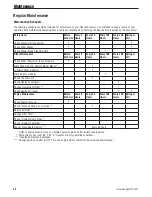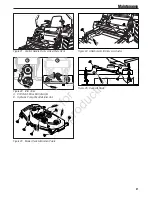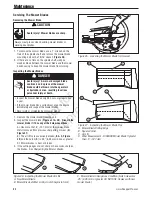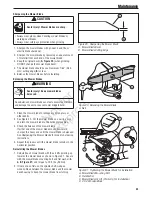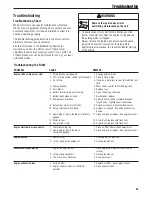
Not for
Reproduction
37
Figure 36. Return-to-Neutral Adjustment
A. Return Spring
B. Set Collar
A
B
B
A
Figure 38. Parking Brake Adjustment
A. Brake Spring
B. Adjustment Nut
2-1/4”
(5,72 cm)
Figure 37. Remove the Kick Plate
A. Kick Plate
A
B
A
Maintenance
Return-to-Neutral Adjustment
Checking the Adjustment:
To determine if it is necessary to adjust the neutral return,
perform the following steps.
1. Disengage the PTO, engage the parking brake and turn
off the engine.
2. Move the ground speed control levers into the operating
position, pull the levers rearward and release.
3. Move the ground speed control levers out towards the
neutral position. If the levers do not align with the
notches in the neutral lock plate, it is necessary to adjust
the neutral return rod.
Adjustment:
1. Loosen the set collar (
B, Figure 36
) locked against the
return spring (
A
).
2. Lock the ground speed control levers in neutral.
3. Tighten the set collar snug against the return spring
4. Pull the ground speed control levers rearward and
release to check that the lever stops aligned with the
notch in the neutral lock plate.
NOTE: It is important to note that after every adjustment of
the neutral return spring, the lever must be returned to the
locked position to properly check the neutral position.
Parking Brake Adjustment
1. Disengage the PTO, engage the parking brake, stop the
engine and remove the ignition key.
2. Remove the kick plate (
A, Figure 37
)
3. Locate the brake spring (
A, Figure 38
).
4. With the parking brake engaged, measure the
compressed spring length. The spring should be 2-1/4”
(5,72 cm) when compressed.
5. If the spring does not measure 2-1/4” (5,72 cm), release
the parking brake and turn the adjustment nut (
B
) to
compress or relax the spring.
6. Engage the parking brake and re-measure the spring.
7. Once the measurement of 2-1/4” (5,72 cm) is achieved,
re-install the kick plate.
NOTICE
Do NOT adjust the spring to be shorter than 2-1/4” (5,72
cm) when compressed. This may damage the brake
mechanism.






